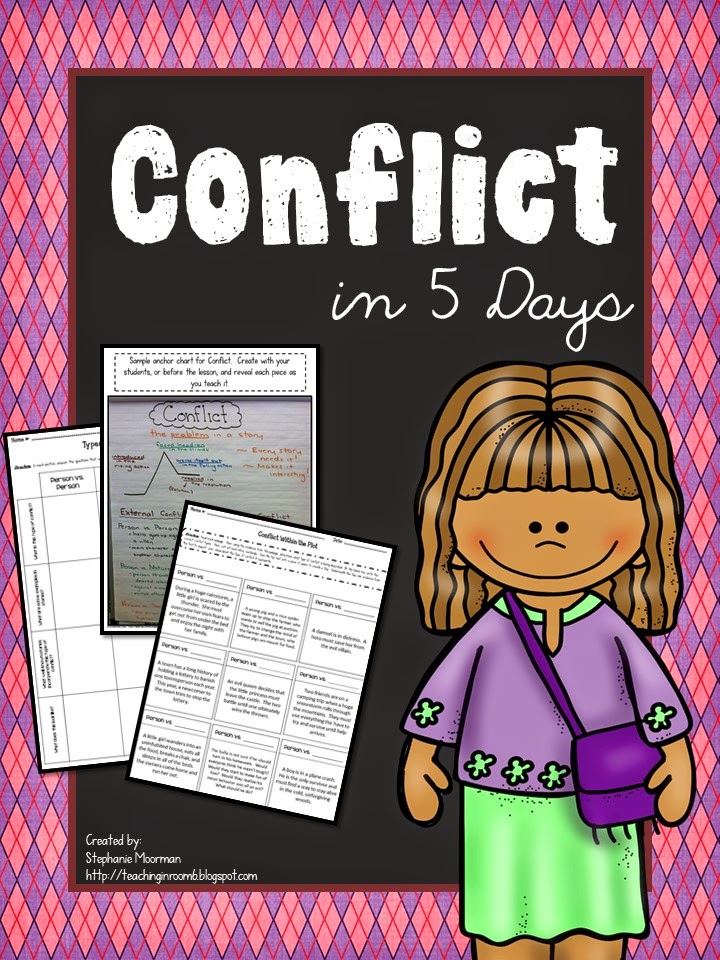So this week, we focused on *conflict* in a story. We have tackled plot, character, and setting, so it seemed only natural that conflict would follow. Here is the basic rundown of what we did.
I began the week, like I have with all of the other weeks, with an anchor chart. I just really like how week after week I can go back and refer to them for the students. Everything is building upon everything else, so it is easy to reference the charts that we have made together.
Our chart laid out what conflict is in a story. Basically, it drives the story and makes it interesting. Without some sort of problem, the story would be so boring! To illustrate this point, I told the kids the most boring story about me getting ice cream.
"I went to the store to buy ice cream. I got it. I went home and ate it."
I asked them if they liked my story. The resoundingly said NO! Duh...it was boring. Why? Because it had no conflict, no problem! So I then told them another story.
"I went to the store to get ice cream but they were out of the flavor I wanted. So, being the resourceful lady that I am, I went into the storeroom to see if there was any more. To my surprise, when I got there, a young man about half my age said to me, 'Ma'am, you can't be in here' and started to chase me! I was so scared I screamed...and then started running. He was chasing me all around, yelling 'Get out of here!' and I just kept running away from him."
I then stopped and asked them if they wanted to hear more. This time it was a resounding YES! Why? Because my story now had some conflict. Something was interesting and pulling everyone in.
We then discussed the four main types of conflict that are usually found in fiction (I know there are a few more, but we focused on four.) I wrote them on the anchor chart as the kids took notes. Here is what our chart ended up looking like.
 Then, I gave them a grid to sort out what we talked about as a class. I had them work in pairs to come up with a definition for each type of conflict, an example of each, a book it works in, and a picture. You can get that grid {here}.
Then, I gave them a grid to sort out what we talked about as a class. I had them work in pairs to come up with a definition for each type of conflict, an example of each, a book it works in, and a picture. You can get that grid {here}.The next day, we reviewed and then I gave them some plot summaries that served as examples of each type of conflict. They had to decide the conflict, underline the evidence of that conflict, cut it out, and then write (interactive notebook style) the reason they thought that conflict type fit.
Here is where the week got really hard. We looked a picture book they had read before (Madeline
They talked it out, found the conflict in their story, and got to work writing their own paragraph-long story that included all the elements of plot (since we have discussed this at length) and elements of conflict.
Seriously, this was a HARD lesson, but SO worth it. The stories are just a million times better now than when I began diving into all of these narrative elements lessons. And adding conflict in finally has kicked their writing and understanding of stories up to that next level. I am very, very happy with what is happening right now in Room 6!
 If you would like full lesson plans and examples (more than what I have described here in my post), you can pick up my Conflict in 5 Days pack in my TpT store.
If you would like full lesson plans and examples (more than what I have described here in my post), you can pick up my Conflict in 5 Days pack in my TpT store.How do you teach conflict?




This is exactly what we're working on, too!! Thanks for the simple (yet very clear) anchor chart! Conflict is often so hard to grasp; this makes is very doable. I'm going to try next week! Thanks, Stephanie!
ReplyDeleteStephanie, I was wondering what kind of formative assessments you did each day to make sure they were getting it? I bought the 5 day and starting next Monday!
ReplyDelete